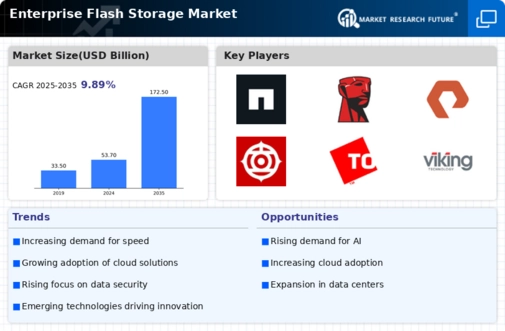Rising Data Volume
The exponential growth of data generated across industries drives demand in the Global Enterprise Flash Storage Market Industry. As organizations increasingly rely on data analytics and cloud computing, the need for efficient storage solutions becomes paramount. In 2024, the market is projected to reach 53.7 USD Billion, reflecting a growing recognition of flash storage's ability to handle large volumes of data with speed and reliability. Companies are investing in flash storage to enhance their data management capabilities, ensuring they can process and analyze information swiftly to maintain a competitive edge.
Market Growth Projections
The Global Enterprise Flash Storage Market Industry is poised for substantial growth, with projections indicating a market size of 53.7 USD Billion in 2024 and an anticipated increase to 172.5 USD Billion by 2035. This growth trajectory suggests a compound annual growth rate of 11.2% from 2025 to 2035, reflecting the increasing reliance on flash storage solutions across various sectors. The market's expansion is driven by factors such as rising data volumes, technological advancements, and the growing adoption of cloud services, positioning flash storage as a critical component of modern data management strategies.
Focus on Energy Efficiency
The emphasis on energy efficiency in data centers is becoming a pivotal factor in the Global Enterprise Flash Storage Market Industry. As organizations strive to reduce operational costs and minimize their carbon footprint, energy-efficient storage solutions gain prominence. Flash storage typically consumes less power compared to traditional hard disk drives, making it an attractive option for environmentally conscious enterprises. This trend aligns with broader sustainability goals, encouraging companies to invest in flash storage technologies that not only enhance performance but also contribute to energy savings and reduced environmental impact.
Technological Advancements
Continuous advancements in flash storage technology significantly influence the Global Enterprise Flash Storage Market Industry. Innovations such as 3D NAND technology and NVMe interfaces enhance performance and reduce latency, making flash storage more appealing to enterprises. These developments enable organizations to achieve faster data access and improved operational efficiency. As a result, the market is expected to experience a compound annual growth rate of 11.2% from 2025 to 2035, indicating a robust shift towards adopting cutting-edge storage solutions that meet the demands of modern applications and workloads.
Need for Enhanced Performance
The necessity for enhanced performance in data storage solutions propels the Global Enterprise Flash Storage Market Industry forward. Organizations are increasingly aware that traditional storage systems may not meet the performance demands of modern applications, particularly those requiring real-time data processing. Flash storage provides superior speed and efficiency, enabling businesses to optimize their operations. This growing recognition of performance benefits is likely to drive further investments in flash storage technologies, reinforcing the market's trajectory towards significant growth in the coming years.
Increased Adoption of Cloud Services
The growing adoption of cloud services is a key driver for the Global Enterprise Flash Storage Market Industry. As businesses migrate to cloud-based infrastructures, the demand for high-performance storage solutions rises. Flash storage offers the speed and reliability necessary for cloud applications, making it an attractive option for organizations looking to enhance their digital transformation efforts. This trend is expected to contribute to the market's growth, with projections indicating a rise to 172.5 USD Billion by 2035, as enterprises seek to leverage the benefits of cloud computing while ensuring optimal data storage solutions.














